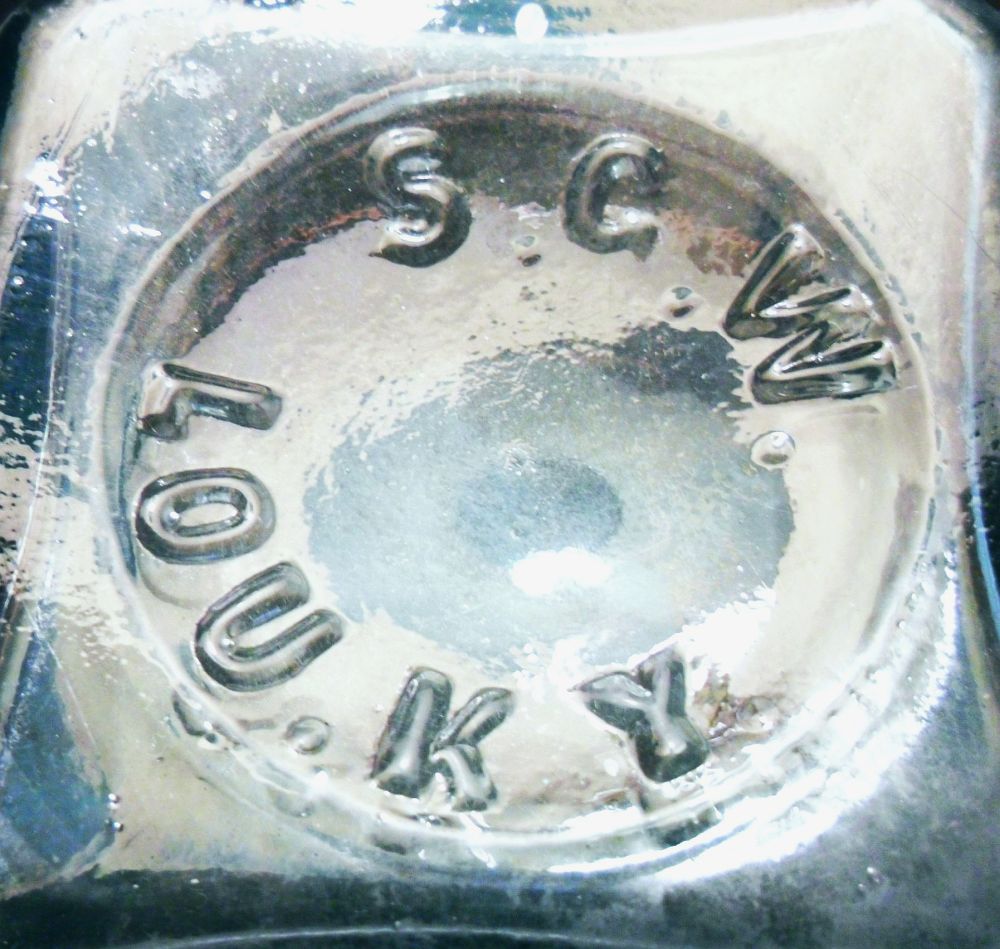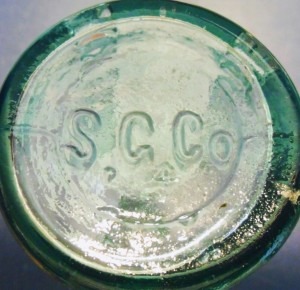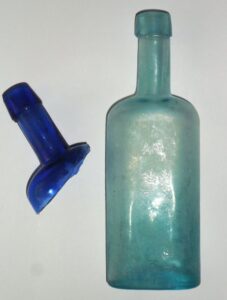Note: the following article was originally published in the Summer 2005 issue of “Bottles & Extras” magazine. This is basically the same article, but with a few edits and some additional text and photos. To see the accompanying pictures that were posted in the magazine, see the original article here.
SOUTHERN GLASS COMPANY, dba “Stanger & Company” (1877-c.1879)
SOUTHERN GLASS WORKS (c.1879- c.1885)
LOUISVILLE GLASS WORKS COMPANY (c. April 1885-January 1886)
This factory site was located on the northwest corner of 11th Street and Monroe (now Rowan) Streets in Louisville.
John Stanger, Sr. , formerly connected with the Kentucky Glass Works/Louisville Glass Works (1850-1873), as well as the the Star Glass Works of New Albany, IN, teamed up with veteran glassblower Charles Doyle, his son-in-law (who had married his daughter Rebecca in 1866) to start up a new firm doing business as “John Stanger & Company” (or just “Stanger & Company” as worded in a newspaper ad) in 1877.
The factory name was referred to as both Southern Glass Company and Southern Glass Works, although the former name seems to have been preferred in the first year or two of business. HOWEVER, both names were probably used interchangeably, to some extent, throughout the entire span of time they were in business.
Others involved in the company were: John Stanger, Jr, Joseph Husak, Frederick Rau, Patrick Daly, Charles Thomasson, Philip Zell, Conrad Opperman and Joseph Markel Stanger (also a son of John, Sr.).
John Schaupp, Thomas F. Stanger, Daniel Powell, John Zell, Edward Koegler, George P. Hess, Henry Geisel, Isaac Delph, James Cunliffe, Charles Cannon, Michael Doyle, and John Rau were some of the glassblowers who were employed there at one time or another.
Other workers at the factory included William Woerner (watchman), Peter Kasheimer (fireman), John Pfarr and William Woods (packers) and Jacob Court (potmaker). Incidentally, in 1888 glassblower John Rau was to become involved in the start-up of the Fairmount Glass Works at Fairmount, Indiana, and later (at least by 1904), he was president of that company with several of his sons also involved in the operation.
John Stanger held the position of superintendent of the window glass department of W.C. DePauw’s Star Glass Works in New Albany, Indiana during the c.1871-1877 stretch and evidently decided to embark upon yet another venture, as a leading man, on the Louisville side of the Ohio River.
ADVERTISEMENT
According to the CROCKERY & GLASS JOURNAL, an early trade magazine of the glass manufacturing industry, in the August 23, 1877 issue, mention is made that the first bottle production was scheduled to start about ten days later (September 2, 1877). [Thanks to researcher Bob Stahr for finding that article for me].
A brief newspaper ad first appeared for this company in the Louisville Courier Journal, dated Dec 2, 1877.
An advertisement also appeared a few months later (in the 1878 city directory) which reads:
“Southern Glass Company–Cor. Eleventh and Monroe Streets–Near the Canal–Louisville, KY. Our new company is now well established and in full operation. All orders for wine, ale, beer and mineral water bottles, and also for flasks for druggists, and fruit jars, will be promptly filled at lowest rates. We also keep on hand a large stock of the above named goods. Our goods can not be surpassed by those from other factories. We employ only the most competent workmen. Stanger & Co.”

Sometime in 1879 or 1880, John Stanger, Sr, departed and T. H. Sherley & J. G. McCulloch became proprietors of the works. J. L. (John Lewis) McCulloch was listed as bookkeeper, but his relationship to J.G. isn’t clear at this time. (John Lewis McCulloch was to become part owner of the Marion Fruit Jar & Bottle Company of Marion, Indiana, in 1888).

Under the firm name “Sherley & McCulloch” , the period of about 1880 to 1883 seems to have been the most prosperous time for this company, with a large variety of bottles and jars being produced.
Embossed identification marks used by Southern Glass Works on various containers (always found on the base) include:
1) SOU.G.W. (Wax sealer fruit jars)
2) SOU.G.WS. (Square pickle bottles)
3) S. G. W. LOU. KY (Wax sealer jars, medicines, pickle bottles, cathedral pepper sauce bottles, cylinder whiskies, “Hutchinson type” mineral water & soda bottles, many others)
4) S.G.Co. (Round Chemical bottles (often termed “Druggists’ Packers”), Wax sealer jars, “Ginger ovals” [medicine bottles for Jamaica Ginger and often used for bluing], John J. Smith / Louisville, KY tonic bottles)
5) S.G.Co. LOU. KY. (lettering in a circular formation, marked on the base of a RED SNAPPER SAUCE bottle. This bottle is shaped exactly like the typical “Lea & Perrins Worcestershire Sauce” bottles, in aqua with a crude applied lip)
6) S.G.W. (Picnic or “Pumpkinseed” style liquor flasks)


All of the Southern Glass Company bottles encountered have applied lips (that is, a “ring” or band of glass has been added in a second step to form the lip of the bottle, but with no further “tooling” evident which would have otherwise smoothed over the clearly visible line of separation between the lip and the body of the bottle), and they usually show a rather crudely-made appearance more characteristic of the bottles of a somewhat earlier period of time (i.e. the Civil War era). They often contain very prominent bubbles as well as smaller seed and tear bubbles, and exhibit “drippy lips”, swirl or “whittle” marks, faint amber wisps, and other irregularities so attractive to the antique bottle collector.
ADVERTISEMENT
Presumably the “S. G. Co.” marking was used mostly in the first two years or so of operation, although it is likely that some of the bottle molds with that marking were used into later years until they wore out.

NOTE: The S. G. Co. marking was also used by several other glass companies, including the Scranton Glass Company, Scranton, Pa.; Seattle Glass Company, Renton, Washington (1903-1907); Southern Glass Company of Los Angeles, Calif. (1916-1931) ; and the Severn Glass Company of Annapolis, Maryland. Swayzee Glass Company of Swayzee, Indiana also used an “S.G.CO.” but always in the form of a monogram which appears only on fruit jars.
In the case of the Louisville-made bottles, I submit that if a bottle or jar seen with this mark is handblown with a true applied lip, is crudely made, aqua in color, is base-marked, and was found in the Louisville and surrounding area of Kentucky and southern Indiana, it is likely to be a product of Southern Glass Works.

Some notable bottles with the “S. G. W. LOU. KY” mark include a variant of the” K C & CO” hutch sodas (Klee, Coleman & Company, bottlers of mineral water with offices in Dayton, OH and Louisville, KY); Ameliorated Schiedam Holland Gin; S.S. Clarke’s Diamond Family Tonic/ R. H. Higgins & Co.; Brown, Thompson & Company whiskey; and Thos. A. Hurley’s Compound Syrup of Sarsaparilla.
GLASS COLORS
Southern Glass Works made containers in shades of aqua, green, several shades of amber, and (rarely) cobalt blue. The most common color, by far, is aqua (blueish-green), and many slightly different shades of aqua can be seen by comparing various bottles. A particular bottle may appear in an aqua shade that leans somewhat more blue, others may lean in the direction of what might be called “green aqua”. Cylinder whiskey bottles are seen in amber. Although usually found in aqua, one example of a “K C & Co” soda bottle is known in a medium green color. Several “wax sealer style” fruit jars are known in shades of light green and amber.
I can state with 100% certainty that at least a few cobalt blue bottles were made by Southern Glass Works. I have an upper portion of a “ginger oval” type bottle — the typical shape of older JAMAICA GINGER bottles — in cobalt. Although the base portion — thus the glass manufacturer’s mark — is missing, from close examination of that shard, it matches perfectly with an entire bottle in aqua. The mold used to form the bottle has several tiny imperfections (small bumps and indentations) that are unique to that particular mold, and comparing the shard with a complete aqua example, it is obvious the cobalt shard was part of a bottle formed in that same mold. The bottle would be embossed “S. G. W. / LOU. KY.” on the base. If you have seen a complete bottle of this type, or know someone who has one, please contact me as I would love to obtain a photo of that bottle.


It is also possible (but not proven!) that Southern Glass Works was the maker of the very rare Louisville whiskey “pig bottle” which is known in cobalt blue. At this time, only 2 examples are known in cobalt. Because of the time period when they were made, the likely manufacturer was either Southern Glass Works or Kentucky Glass Works Company, also of Louisville.
ADVERTISEMENT
The Southern Glass Works was certainly not in operation for at least part of the time during the years 1884 and 1885. No individual employee listings were found for glassblowers employed by Southern in the city directories from those two years, although the company itself was still listed in the business section. All glassblowers employed by Southern in 1883 are listed as employed elsewhere in ‘84 and ‘85 so I assume that the factory was not actually in operation for all or much of the time during the period, or at least during the period of time when the data for the city directories was being collected.


According to 1884 city directory listings, some of the SGW employees were listed as then working at the Falls City Glass Company, and I feel this serves as strong evidence that the Southern Glass Works shut down operations at some undetermined point in time during 1884, and in fact may have continued to remain idle into the early months of 1885.
In the spring of 1885 this factory re-opened for a short time under the name “Louisville Glass Works Company”, as discussed below:
Louisville Glass Works Company (c. April 1885-January 1886)
A listing for the “Louisville Glass Works Company” appears in the 1886 Louisville city directory. This company was a reopening of the Southern Glass Works factory location at 11th and Monroe streets, but with a new—and confusingly similar—firm name.
Joseph M. (Markel) Stanger, son of John Stanger, Sr., was listed as the superintendent, and a number of the employees of the Southern Glass Works operation were employed there as well. The operation evidently was quite unsuccessful, and in January of 1886 an item appeared in the COURIER JOURNAL stating that two employees, George Coleman & John Flynn, both glassblowers, were suing the defunct company in Common Pleas court for wages due them which they had not received.
No marked bottles or jars are known as far as I am aware, but there is a good likelihood they continued to use some of the old molds with the Southern Glass markings on them. One reference (Henry Charles Edelen, Nineteenth-Century Kentucky Glass, April 1974 issue, Magazine Antiques), states that they produced bottles with an “LGWC” entwined logo, but I know of no evidence to show there is any truth to that statement and I suspect that to be a nonexistent (or misattributed) mark.
Possible short-term reopening of Southern Glass Works (c.1887-1889?)
After this factory (under the name of Louisville Glass Works Company) closed in January 1886, there is some confusion on the exact chain of events during the following 2 to three years. According to a brief mention in the book “The City of Louisville and a glimpse of Kentucky”, written by Young Ewing Allison and published in 1887, the whisky distiller T. H. Sherley & Company “leased” the Southern Glass Works (and Kentucky Glass Works), presumably to make sure his company had enough bottles for their products. This implies that the Southern Glass Works factory had recently reopened and then operated for an undetermined period of time.
Allison writes: “In addition to its dealings in whisky, within the past few months the firm [T.H. Sherley & Co] has leased both the Southern Glass Works and the Kentucky Glass Works [Company], and is now actively operating those enterprises. The same activity and sagacity which Mr. Sherley has always displayed in his other pursuits, warrant a prediction of great success in his latest venture.”
However, from a search of Louisville city directories of the 1886-1889 period, even though the business sections still listed the Southern Glass Works, there are no listings of individual glassblowers working there during those years. Assuming there was a reopening of SGW in 1887, it was probably very short-lived, very sporadic, or it was closed at the time information was being gathered for those city directory issues.
Whatever the case may be, the Sanborn fire insurance maps shows the old glass factory was in “ruins” in 1892. By 1905 the Sanborn maps indicate the building was no longer in existence and Illinois Central Railroad tracks covered much of the site.
The location where this factory once stood is very close to the Interstate 64 highway which passes just a few feet north of the site.
For more information on Louisville-area glass, please see this page.
Click here to see my article about another Louisville glass factory, the Kentucky Glass Works Company. That company was in business during the same general period of time Southern Glass Works was in operation.
For an extensive list of glass manufacturers’ marks on bottles, fruit jars, electrical insulators, tableware and other items, please click here to go to the GLASS BOTTLE MARKS pages, page one.
Click here to go to my Home Page.
ADVERTISEMENT


I have a bottle and I am trying to date and find area of birth – it has Texize on the side and LGW 5 on bottom.
Nick, that was evidently a bleach or other type of liquid chemical or cleanser product bottle. The “LGW” likely stands for Lauren Glass Works of Laurens, South Carolina.
~David
Just found the bottom and parts of a jar, I think, from the SGW LOU KY while digging out a portion of my basement. House was built in 1907. numerous other bottles and crocks have been found…2 nice complete Mason jars, a soda from Enid, OK, food bottles, 3 crocks, and some other embossed food jars.
Do you have any thing on RIVO Cola of Louisville,KY dark amber color straight sided crown top.
Hi Jeremy,
There isn’t a lot of info on this brand, but here’s what I’ve been able to glean so far: Rivo was a brand of sodas marketed and sold in the Louisville Ky. area by Merchant’s Ice & Cold Storage Company. Most of the bottles appear to have been made sometime in the 1900-1920 period. Known glass manufacturers who made them include Root Glass Company, Terre Haute, IN, (R. G. CO.) and D. O. Cunningham of Pittsburgh (D.O.C.). There are no doubt bottles with other makers’ marks out there also. (None of the Rivo bottles were actually made IN Louisville, as by that time all glass bottle makers in Louisville had long been out of business).
Rivo-Cola was one of the many, many local and regional competitors to Cola-Cola. I’ve seen bottles in dark amber and “Coca-cola bottle green” or “light green aqua”. They are practically identical in style to the early “straight sides” Coca-Cola bottles of the 1910s.
~David